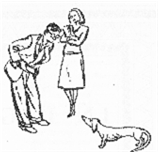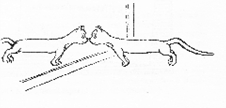There are special names for some of the more amusing uses (and misuses) of English. Some of them refer to certain kinds of verse, others to word games and curiosities, stupid blunders, witty remarks, and so on.
In each of the next three exercises you are given several of these special names, followed by one example of each—but not in the same order. To find which is which, look up the given words in any convenient reference book, and then ask yourself which examples fit the meanings of these words exactly.
parody: doggerel: malapropism: pun: repartee: portmanteau word
-
This verse is taken from a version of the panto mime Aladdin that was produced in 1866. What is the proper name for this so-called poetry ?
A feeble widow whom you’ve treated cruel
Is quite prepared to give you some gruel;
The same weak widow, with unruffled brow
In gentle language asks you, “What’s the row?”
Resume your studies, dears, you know my maxim—
The boy who’s last in reaching school, I whacks him.
-
A holiday-maker from the city, who had lost his way in the country, saw a village boy at the cross roads and asked him where the other three roads led to. All that the boy could tell him was that one led to the farm, one to the church, and one to the pump.
“You call yourself a clever lad, I suppose,” said the man sarcastically.
“No,” replied the boy, “but I’m not lost.”
What name do we give to a quick-witted retort like this?
-
A mixture of smoke and fog is called smog, and motorized pedal-cycles have been called mopeds. What are words of this sort called?
Suggest a suitable trading-name (a single word) for a firm in which the two partners are named Corfield and Hanbury.
-
What do we call the figure of speech on which this joke depends?

“That’s a queer beast; what is it?”“A pedigree dachshund. He has two flaws, though.”
“Looks more like a bungalow to me.”
-
A man who was a little confused was heard to say that the larch is a carnivorous tree. Explain his mistake, and say what name we give to it (the mistake, not the tree).
-
What name is given to this kind of imitation?
Rumble, rumble, little jet; How the dickens did you get Up above the world so high, Like a blow-lamp in the sky?
sarcasm: high-flown English: double negative: spoonerism: redundancy: mixed metaphors
-
A girl was heard to say that she had learned to ride a two-wheeled bicycle. What error was she guilty of in her English ?
-
A man who meant to say, I deal at the stores said I steal at the doors. What is a mistake of this sort called ?
What did he mean when he said that the destruction of his home by fire was a blushing crow?
-
The following sentence, taken from a newspaper report of a football match, is typical of an artificial style of writing that is not as common nowadays as it used to be. What is English of this kind called?
Marriott, the Wanderers’ pocket-sized skipper, baffled the custodian with his fancy footwork and banged the leather into the onion-bag.
Say the same thing in plain English.
-
Mr. Oddman was an eccentric person, and was for ever making mistakes and getting his facts wrong. An acquaintance said of him,
He’s a queer fish—always barking up the wrong tree.
There is a special name for this sort of confused description; what is it ?
-
John said of Tom, He never has no money in his pocket. If John really meant exactly what he said, was Tom ever without money ?
If John was using English badly, what mistake was he making?
-
A naval instructor who found one of his cadets completely entangled in a rope said to him,
Very pretty! Very pretty! All we want now is a little dab of sealing wax.
What figure of speech was he using ?
irony: anti-climax: paradox: ambiguity: palindrome: hyperbole
-
Introducing a lecturer to his audience, the chair man said,
If I tried to tell you anything about the subject of the lecture I should only display my ignorance. I prefer to leave that to the professor.
The audience tittered. What do we call the mistake that caused their amusement?
-
Mrs. Gay described Mrs. Weep as the kind of person who is never happy unless she is feeling sorry for someone.
Mrs. Gay contradicted herself, but we know very well what she meant. What do we call a self-contradictory statement of this sort?
-
This is how a boy described a war-time pilot in an essay. The other boys in the class laughed when the passage was read out to them. Why?
Andy was the hero of the squadron. He had shot down ten enemy aircraft, and had baled out several times. No-one could beat him at aerobatics. He was also good at darts.
What name is given to a construction of this kind?
-
Donald said to Richard, Eric has tons of conkers in his desk.
Give the technical name for this kind of exaggeration.
-
Tired of waiting for the railway station in his town to be modernized, a resident tries to shame the authorities into action by means of an article in the local newspaper. Here are some of the things he says about the station:
Unstained by paint, the building has acquired distinctive natural shades of grime-grey and rust-red. The roof of the booking-hall, embellished with an unusual pattern of perforations, affords pleasing glimpses of the sky, and the ventilation leaves nothing to be desired. The oldest inhabitants of the town recall the days when coal was actually burned in the waiting-room grate, and it is stated on reliable authority that the material in the window-frames was at one time transparent. There is as yet no confirmation of the rumour that the building is to be scheduled as an Ancient Monument.
What name is given to this style of writing?
-
Read the following sentence backwards, letter by letter, and see what you notice about it.
Draw no dray a yard onward
What is this kind of sentence called? Here is the first half of another sentence of the same kind. See if you can complete it.
WAS IT A C.. . … ?

